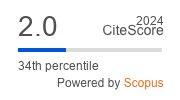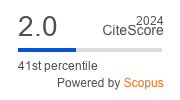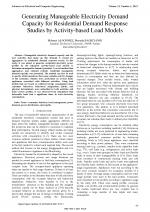| 1/2021 - 11 | View TOC | « Previous Article | Next Article » |
Generating Manageable Electricity Demand Capacity for Residential Demand Response Studies by Activity-based Load ModelsSONMEZ, M. A. |
| Extra paper information in |
| Click to see author's profile in |
| Download PDF |
Author keywords
consumer behavior, load management, power demand, power distribution, smart grids
References keywords
energy(21), buildings(13), jenbuild(9), domestic(9), electricity(8), modeling(7), model(6), demand(5), consumption(5), building(5)
Blue keywords are present in both the references section and the paper title.
About this article
Date of Publication: 2021-02-28
Volume 21, Issue 1, Year 2021, On page(s): 99 - 108
ISSN: 1582-7445, e-ISSN: 1844-7600
Digital Object Identifier: 10.4316/AECE.2021.01011
Web of Science Accession Number: 000624018800011
SCOPUS ID: 85102815185
Abstract
Manageable electricity demand capacity and the user activities that make up this demand is crucial for aggregators in residential demand response events. In this study, it was aimed to generate residential electricity power profiles by the enhanced activity-based load models to determine manageable demand potential. A novel method that aggregators may estimate realistic residential manageable demand capacity was presented. The method can also be used to specify which incentives that cause suitable activity changes of the consumer. Studies were performed on several home appliances associated with different activities. Using load models that are based on collected energy consumption data, consumer behaviors, behavioral adaptations, habits, and physical determinants were embedded in both activities and loads' power profiles. It was observed from simulations that deferrable loads had a significant share in total electricity consumption. |
| References | | | Cited By «-- Click to see who has cited this paper |
| [1] H. Wang, G. Henri, T. Chin-Woo, and R. Rajagopal, "Activity detection and modeling using smart meter data: concept and case studies," IEEE Power & Energy Society General Meeting, August 2020
[2] T. Liu, X. Ding, and N. Gu, "A generic energy disaggregation approach: What and when electrical appliances are used," in 2015 IEEE International Conference on Data Mining Workshop (ICDMW), Nov. 2015, pp. 389-397, [CrossRef] [SCOPUS Times Cited 7] [3] J. Widen and E. Wackelgard, "A high-resolution stochastic model of domestic activity patterns and electricity demand," Applied Energy, vol. 87, no. 6, pp. 1880-1892, Jun. 2010, [CrossRef] [SCOPUS Times Cited 460] [4] P. Hoes, J. L. M. Hensen, M. G. L. C. Loomans, B. de Vries, and D. Bourgeois, "User behavior in whole building simulation," Energy and Buildings, vol. 41, no. 3, pp. 295-302, Mar. 2009, [CrossRef] [SCOPUS Times Cited 525] [5] L. Klein et al., "Coordinating occupant behavior for building energy and comfort management using multi-agent systems," Automation in Construction, vol. 22, pp. 525-536, Mar. 2012, [CrossRef] [SCOPUS Times Cited 306] [6] T. Hong, D. Yan, S. D'Oca, and C. Chen, "Ten questions concerning occupant behavior in buildings: The big picture," Building and Environment, vol. 114, pp. 518-530, Mar. 2017, [CrossRef] [SCOPUS Times Cited 456] [7] D. Calì, R. K. Andersen, D. Müller, and B. W. Olesen, "Analysis of occupants' behavior related to the use of windows in German households," Building and Environment, vol. 103, pp. 54-69, Jul. 2016, [CrossRef] [SCOPUS Times Cited 143] [8] R. Yao and K. Steemers, "A method of formulating energy load profile for domestic buildings in the UK," Energy and Buildings, vol. 37, no. 6, pp. 663-671, Jun. 2005, [CrossRef] [SCOPUS Times Cited 445] [9] O. Motlagh, P. Paevere, T. S. Hong, and G. Grozev, "Analysis of household electricity consumption behaviours: Impact of domestic electricity generation," Applied Mathematics and Computation, vol. 270, pp. 165-178, Nov. 2015, [CrossRef] [SCOPUS Times Cited 42] [10] C. Oberst and R. Madlener, "Prosumer Preferences Regarding the Adoption of Micro-Generation Technologies: Empirical Evidence for German Homeowners," Social Science Research Network, Rochester, NY, SSRN Scholarly Paper ID 2670035, Sep. 2015. [CrossRef] [11] A. H. McMakin, E. L. Malone, and R. E. Lundgren, "Motivating Residents to Conserve Energy without Financial Incentives," Environment and Behavior, vol. 34, no. 6, pp. 848-863, Nov. 2002, [CrossRef] [SCOPUS Times Cited 166] [12] F. McLoughlin, A. Duffy, and M. Conlon, "Characterising domestic electricity consumption patterns by dwelling and occupant socio-economic variables: An Irish case study," Energy and Buildings, vol. 48, pp. 240-248, May 2012, [CrossRef] [SCOPUS Times Cited 374] [13] H. A. Aalami, M. P. Moghaddam, and G. R. Yousefi, "Modeling and prioritizing demand response programs in power markets," Electric Power Systems Research, vol. 80, no. 4, pp. 426-435, Apr. 2010, [CrossRef] [SCOPUS Times Cited 442] [14] L. G. Swan and V. I. Ugursal, "Modeling of end-use energy consumption in the residential sector: A review of modeling techniques," Renewable and Sustainable Energy Reviews, vol. 13, no. 8, pp. 1819-1835, Oct. 2009, [CrossRef] [SCOPUS Times Cited 1620] [15] A. Capasso, W. Grattieri, R. Lamedica, and A. Prudenzi, "A bottom-up approach to residential load modeling," IEEE Transactions on Power Systems, vol. 9, no. 2, pp. 957-964, May 1994, [CrossRef] [SCOPUS Times Cited 420] [16] J. V. Paatero and P. D. Lund, "A model for generating household electricity load profiles," International Journal of Energy Research, vol. 30, no. 5, pp. 273-290, 2006, [CrossRef] [SCOPUS Times Cited 431] [17] M. Stokes, "Removing barriers to embedded generation: a fine-grained load model to support low voltage network performance analysis," 2005, Accessed: Sep. 06, 2020. [Online]. Available: https://dora.dmu.ac.uk/handle/2086/4134 [18] S. Firth, K. Lomas, A. Wright, and R. Wall, "Identifying trends in the use of domestic appliances from household electricity consumption measurements," Energy and Buildings, vol. 40, no. 5, pp. 926-936, Jan. 2008, [CrossRef] [SCOPUS Times Cited 262] [19] T. Zhang, P.-O. Siebers, and U. Aickelin, "Modelling electricity consumption in office buildings: An agent based approach," Energy and Buildings, vol. 43, no. 10, pp. 2882-2892, Oct. 2011, [CrossRef] [SCOPUS Times Cited 94] [20] E. de Groot, M. Spiekman, and I. Opstelten, "361: Dutch Research into User Behaviour in Relation to Energy Use of Residences," p. 5, 2008 [21] Y. S. Lee and A. M. Malkawi, "Simulating multiple occupant behaviors in buildings: An agent-based modeling approach," Energy and Buildings, vol. 69, pp. 407-416, Feb. 2014, [CrossRef] [SCOPUS Times Cited 172] [22] I. Richardson, M. Thomson, and D. Infield, "A high-resolution domestic building occupancy model for energy demand simulations," Energy and Buildings, vol. 40, no. 8, pp. 1560-1566, Jan. 2008, [CrossRef] [SCOPUS Times Cited 488] [23] I. Richardson, M. Thomson, D. Infield, and A. Delahunty, "Domestic lighting: A high-resolution energy demand model," Energy and Buildings, vol. 41, no. 7, pp. 781-789, Jul. 2009, [CrossRef] [SCOPUS Times Cited 162] [24] M. Stokes, M. Rylatt, and K. Lomas, "A simple model of domestic lighting demand," Energy and Buildings, vol. 36, no. 2, pp. 103-116, Feb. 2004, [CrossRef] [SCOPUS Times Cited 115] [25] L. Bottaccioli, S. Di Cataldo, A. Acquaviva, and E. Patti, "Realistic Multi-Scale Modeling of Household Electricity Behaviors," IEEE Access, vol. 7, pp. 2467-2489, 2019, [CrossRef] [SCOPUS Times Cited 35] [26] ***, KONDA "Report on social gender in Turkey: The Life-Styles Survey," (in Turkish), 2018 [27] R. Stamminger et al., "Synergy potential of smart appliances," Nov. 2008 [28] D. S. Parker, P. Fairey, and J. D. Lutz, "Estimating daily domestic hot-water use in North American Homes," ASHRAE Transactions, vol. 121, no. 2, pp. 258-271, Jul. 2015 Web of Science® Citations for all references: 0 SCOPUS® Citations for all references: 7,165 TCR Web of Science® Average Citations per reference: 0 SCOPUS® Average Citations per reference: 247 ACR TCR = Total Citations for References / ACR = Average Citations per Reference We introduced in 2010 - for the first time in scientific publishing, the term "References Weight", as a quantitative indication of the quality ... Read more Citations for references updated on 2025-06-30 20:45 in 146 seconds. Note1: Web of Science® is a registered trademark of Clarivate Analytics. Note2: SCOPUS® is a registered trademark of Elsevier B.V. Disclaimer: All queries to the respective databases were made by using the DOI record of every reference (where available). Due to technical problems beyond our control, the information is not always accurate. Please use the CrossRef link to visit the respective publisher site. |
Faculty of Electrical Engineering and Computer Science
Stefan cel Mare University of Suceava, Romania
All rights reserved: Advances in Electrical and Computer Engineering is a registered trademark of the Stefan cel Mare University of Suceava. No part of this publication may be reproduced, stored in a retrieval system, photocopied, recorded or archived, without the written permission from the Editor. When authors submit their papers for publication, they agree that the copyright for their article be transferred to the Faculty of Electrical Engineering and Computer Science, Stefan cel Mare University of Suceava, Romania, if and only if the articles are accepted for publication. The copyright covers the exclusive rights to reproduce and distribute the article, including reprints and translations.
Permission for other use: The copyright owner's consent does not extend to copying for general distribution, for promotion, for creating new works, or for resale. Specific written permission must be obtained from the Editor for such copying. Direct linking to files hosted on this website is strictly prohibited.
Disclaimer: Whilst every effort is made by the publishers and editorial board to see that no inaccurate or misleading data, opinions or statements appear in this journal, they wish to make it clear that all information and opinions formulated in the articles, as well as linguistic accuracy, are the sole responsibility of the author.



